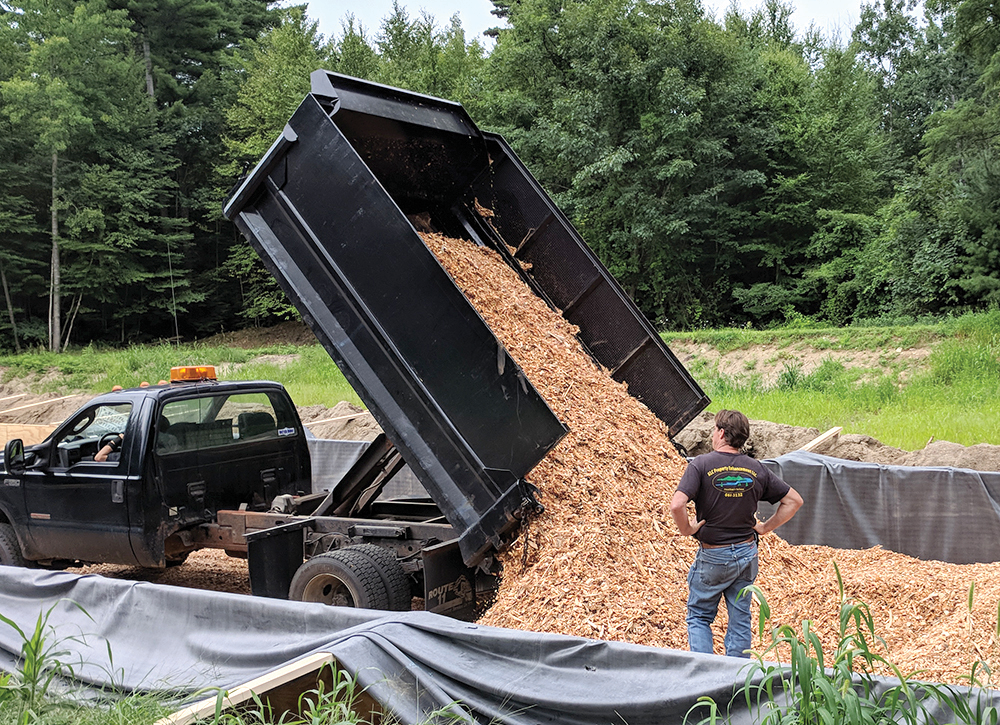
Courtesy LGA
In what the Lake George Association believes to be the world’s first use of a woodchip bioreactor at a municipal wastewater treatment plant, the Town of Bolton is using woodchips to reduce the release of algae-causing nitrate into groundwater and a tributary that feeds Lake George.
A 27-month monitoring study conducted by the LGA, Lake George Waterkeeper and the town, found that the town’s woodchip bioreactor removed 38 percent of nitrate from the wastewater that flowed through it, compared to 0 percent removal of nitrate from the rest of the plant’s effluent stream.
The study was funded by a Lake Champlain Sea Grant.
Nitrate is a chemical compound present in organic waste that, when discharged to water in high quantities and over long periods of time can result in human and ecosystem health problems and foster the growth of algae, including harmful algal blooms (HABs). The Bolton wastewater treatment plant was constructed in the late 1950s and early 1960s and, like other plants of that era, is lacking the denitrification stage found in modern-day plants that converts nitrate to nitrogen gas and releases it harmlessly into the air.
Instead, nitrate is discharged as part of the effluent to sand infiltration beds where it enters the groundwater and sometimes resurfaces and flows into nearby tributaries, the LGA said. The bioreactor adds a wholly natural denitrification process to Bolton’s treatment capabilities.
When wastewater is diverted from the treatment plant through the bioreactor—an underground cell, 20 feet wide and 100 feet long, filled with a bed of Adirondack woodchips four feet deep—bacteria in the water feed on carbon from the chips and take their oxygen from the nitrate, converting it to nitrogen gas. Officials said the process has been widely used in treating high-nitrate runoff from agricultural lands in the Midwest for more than a decade.
The Bolton bioreactor was the brainchild of the town’s consulting engineer, Kathy Suozzo, and was funded by a $50,000 grant from The FUND for Lake George, which has since merged with the LGA. It was constructed by the town’s treatment plant and public works staffs, with volunteer assistance from local logging contractor Barry Kincaid, who supplied the woodchips.
It began operation as a demonstration project in October 2018 and treated approximately 30 percent of the plant’s total wastewater flow until being temporarily taken offline in June 2021 for maintenance and structural improvements.
Officials said the demonstration project was so successful that the town applied for and recently received a state Water Quality Improvement Project grant of $246,000 for the construction of two additional bioreactors. It is expected that the three together will be capable of treating all of the town’s wastewater flow, which ranges from 80,000-275,000 gallons per day, depending on the time of year.
“We were absolutely thrilled to partner with the LGA on this demonstration project and can’t wait to expand and improve upon Bolton’s world-leading use of this natural process to protect Lake George,” said Bolton Supervisor Ron Conover. “I want to thank our treatment plant operators, Matt Coon and Justin Persons, for embracing and quickly becoming experts in this technology. The process may sound simple on the surface, but it requires a very careful balancing of a wide variety of complex factors to ensure that the bacteria are working to their optimum levels.”
“The Town of Bolton is leading by example in its use of a renewable natural resource— woodchips—to protect an irreplaceable natural treasure, Lake George,” said LGA President Eric Siy. “The bioreactor exemplifies the value of the committed public-private partnerships that are at the heart of the LGA’s broader Lake protection program. Together with Bolton and our other partners, we are not only providing an unprecedented level of protection, Lake George is becoming a recognized model for freshwater protection around the world.”
“Over the past two years, our study demonstrated conclusively that the woodchip bioreactor is an effective, affordable and environmentally compatible nitrate-reduction tool for smaller municipal treatment plants like Bolton’s that were constructed decades ago, prior to the advent of denitrification technology,” said Lake George Waterkeeper Chris Navitsky, who conducted the study along with water quality scientist and LGA science advisor Dr. Jim Sutherland. “We look forward to working with the town in the months ahead to further refine its processes for the long-term health of the Lake and the benefit of other communities who can learn from Bolton’s success.”
The Waterkeeper is a program of the LGA.
Sutherland, the principal researcher, said the research team is planning to write a peer-reviewed scientific journal manuscript to describe and share the project with other scientists.
“This will be an extremely important publication that needs to be shared globally,” he said. “We took a concept previously applied to agriculture and aquaculture and developed the first in-situ, real-time application that successfully reduces reactive nitrogen in wastewater from entering the aquatic ecosystem.
“Reactive nitrogen is a problem globally and this Lake George demonstration project has huge implications and potential application around the world.”
“Excess nutrient loading on Lake George threatens local biodiversity, ecology, and water quality and spans beyond the Lake George drainage basin into the Lake Champlain drainage basin,” said Dr. Kris Stepenuck, extension program leader for Lake Champlain Sea Grant and extension associate professor of watershed science, policy and education at the University of Vermont. “What’s good for Lake George is good for Lake Champlain, and we are pleased to have provided the funding for this very important study.”
Lake Champlain Sea Grant is a cooperative effort of the University of Vermont and SUNY Plattsburgh.
The full bioreactor study can be found online at lakegeorgeassociation.org/bioreactor-study.
